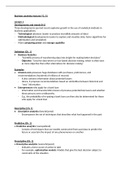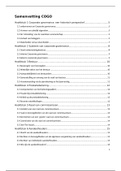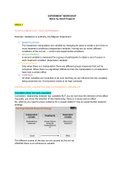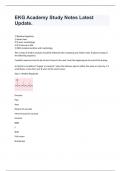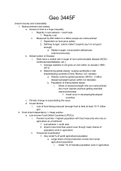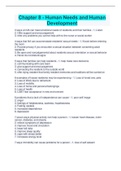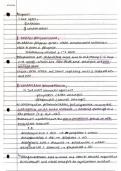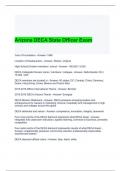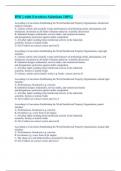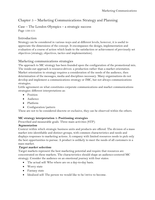Lecture 1
Developments and trends (H1)
Three developments spurred recent explosive growth in the use of analytical methods in
business applications:
- Technological advances (easier to produce incredible amounts of data)
- Methodological developments (easier to explore and visualize data; faster algorithms for
optimization and simulation)
- More computing power and storage capability
Definition (Ch. 1)
Business Analytics
- “Scientific process of transforming data into insight for making better decisions”
- Objective: “Used for data-driven or fact-based decision making, which is often seen
as more objective than other alternatives for decision making”
Examples
• Amazon.com possesses huge databases with purchases, preferences, and
recommendations (hundreds of millions of records)
- It also contains information about potential buyers
- Hence, it proposes recommendations based on similarities between historical and
“new” information
• Entrepreneurs who apply for a bank loan
- Information and characteristics known of previous potential borrowers and whether
these persons were creditworthy
- E.g., the probability of re-paying a bank loan can then also be determined for those
who apply for a bank loan
Descriptive (Ch. 1)
• Descriptive analytics (beschrijvend)
- Encompasses the set of techniques that describes what has happened in the past
Predictive (Ch. 1)
• Predictive analytics (voorspellend)
- Consists of techniques that use models constructed from past data to predict the
future or ascertain the impact of one phenomenon on another
Prescriptive (Ch. 1)
• Prescriptive analytics (voorschrijvend)
- Indicates a best course of action to take
- For example, optimization models: Models that give the best decision subject to
constraints of the situation
,Descriptive (Ch. 1)
• Descriptive analytics
- Encompasses the set of techniques that describes what has happened in the past
- For example, a report summarising relevant information from a large database
- Visualisation techniques (e.g., bar chart)
- Dashboards (e.g., Health app of Apple)
Predictive (Ch. 1)
• Predictive analytics
- Consists of techniques that use models constructed from past data to predict the
future or ascertain the impact of one phenomenon on another
- Use of historical sales data to predict future sales
- Use of purchasing behaviour of consumers to predict market shares
- What are the risk factors of cardiovascular diseases?
- Which characteristics determine whether a soccer team is able to win a match?
- Which factors increase the probability of extending a magazine subscription?
Prescriptive (Ch. 1)
• Prescriptive analytics
- Indicates a best course of action to take
- For example optimization models: Models that give the best decision subject to
constraints of the situation
- What is the best pricing strategy?
- Leverage historical data to determine the timing and level of discounts that maximize
a company’s revenues
- At which location should a factory be opened to meet customer requirements at
minimum costs?
- What financial investments need to be made to achieve superior returns with as little
risk as possible?
- Predictive and prescriptive more advanced than descriptive
Big data (Ch. 1)
• Any set of data that is too large or too complex to be handled by standard data-
processing techniques and typical desktop software
• The 4 V’s
- Volume – volume and file size (data at rest)
- Velocity – speed at which data become available and are analysed (data in motion)
- Variety – various types/forms of data such as text data, audio data, video data, GPS
data, social media data, both structured and unstructured (data in many forms)
- Veracity – uncertainty in the data, e.g. with regard to missing data, inconsistency and
reliability of the data (data in doubt)
- Are there other dimensions that play a role? => VALUE – it should be usefull
,Sub-domains of Business Analytics
• Finance
- Prediction of performance
- Determining optimal stock portfolio
• Human resource (HR) analytics
- How do we improve well-being among employees?
- How do we optimize the work schedules?
• Health care analytics
- How do we speed up the diagnosis process?
• Sports analytics
- How do we optimize the performance of the team?
- Which players in a team are lined up, and at what positions?
- How much is a player worth? How much do we offer them in contract negotiations?
- How do we optimize the design of the car to keep a lasting advantage over the
competition?
- Dynamically adjusting ticket prices throughout the season
• Web analytics
- Analysis of numbers of visitors of websites and social media
- When and where do we place ads?
- How can we best use social networks to promote our products?
How do datasets look like? (Ch. 2)
• Data
- The facts and figures (=information) collected, analysed, and summarized for
presentation and interpretation
• Variable
- A characteristic or a quantity of interest that can take on different values
- Hence the name “variable”; it is about the variation in the data
• Observation
- A set of values corresponding to a set of variables
- So, for each person, firm, country, region, …
• Variation
- The difference in a variable measured over observations
Example dataset (Facebook)
, Data (Ch. 2)
• Often one has a sample rather than the entire population
• Population
- All elements of interest
• Sample
- Subset of the population
- Random sampling: Goal is to gather a representative sample of the population data
• Quantitative / continuous data
- Continuous variables are variables that could take any value (perhaps within some
range)
- Data on which numeric and arithmetic operations, such as addition, subtraction,
multiplication, and division, can be performed
• Categorical data
- Variables recording which category an observation is in
- Data on which arithmetic operations cannot be performed (such as Yes / No
variables)
Where do the data come from?
• Experimental studies
- Individuals randomly assigned to treatment group and control group
- Treatment group is assigned a treatment (controlled environment)
- In this way one gains insight into the causal effect of one variable on another
- Relevant data are collected before and after the study
- The differences before and after are compared between the treatment group and
control group
- For example, the effectiveness of a drug
- Or what the effect of entrepreneurship education is
- “Observational studies”, such as a survey
- Day reconstruction method
Summarising datasets (Ch. 2)
• Important!
• First step in any analysis!
• Descriptive analytics: structure large collections of data into indicators (kengetallen)
Distributions (you summarise datasets through this)
- A description of how often different values occur
- Categorical variables: frequency distribution
- Quantitative variables: histogram (intervals and frequencies)
Summarise the variables


